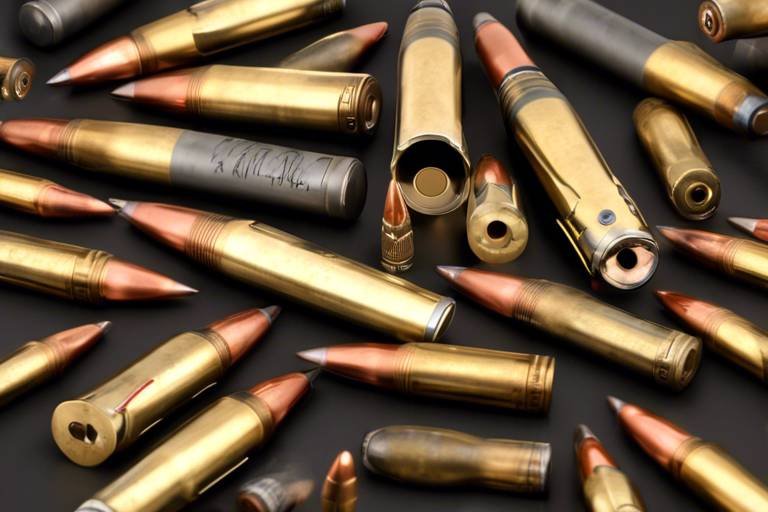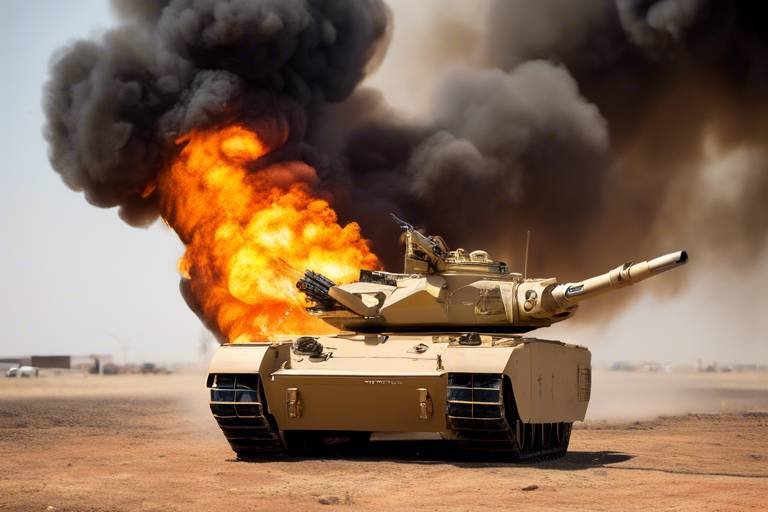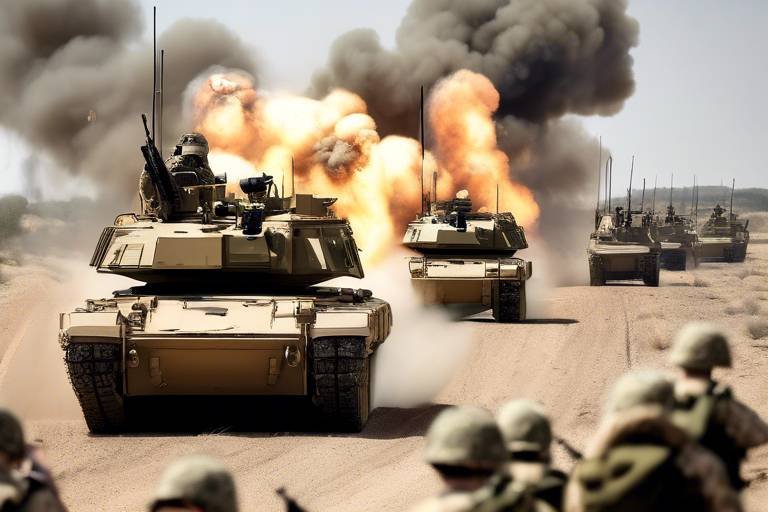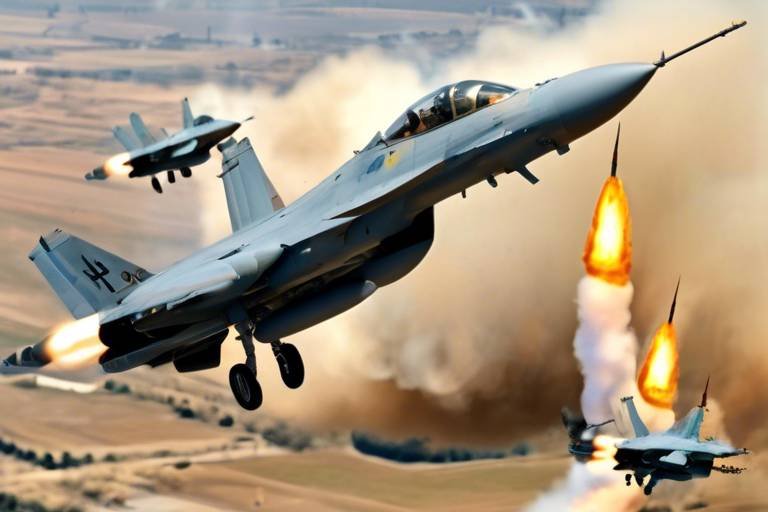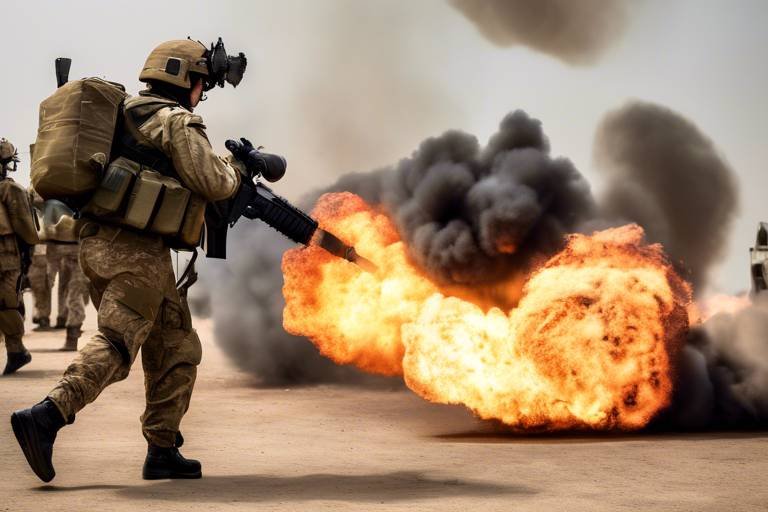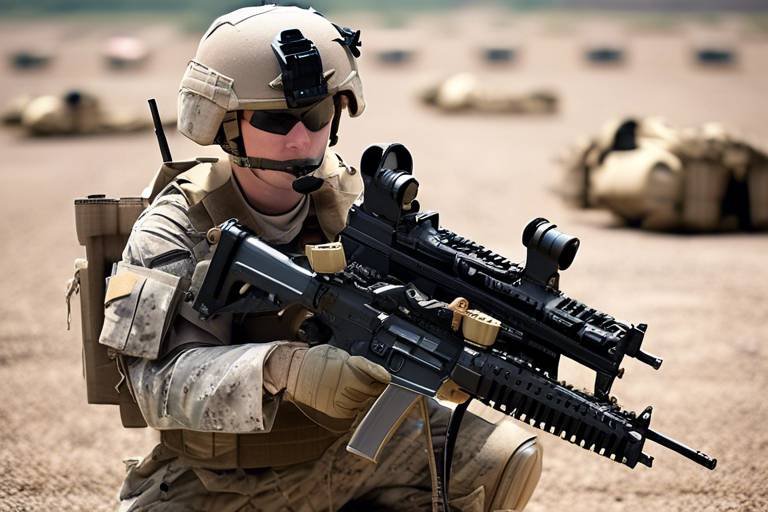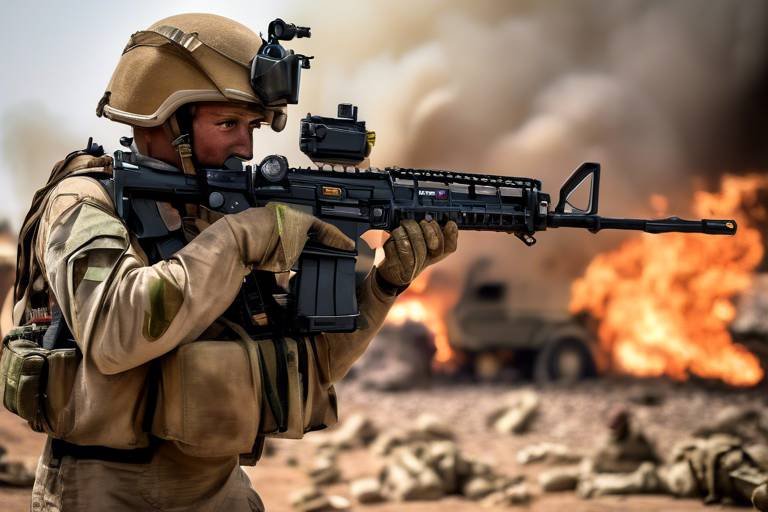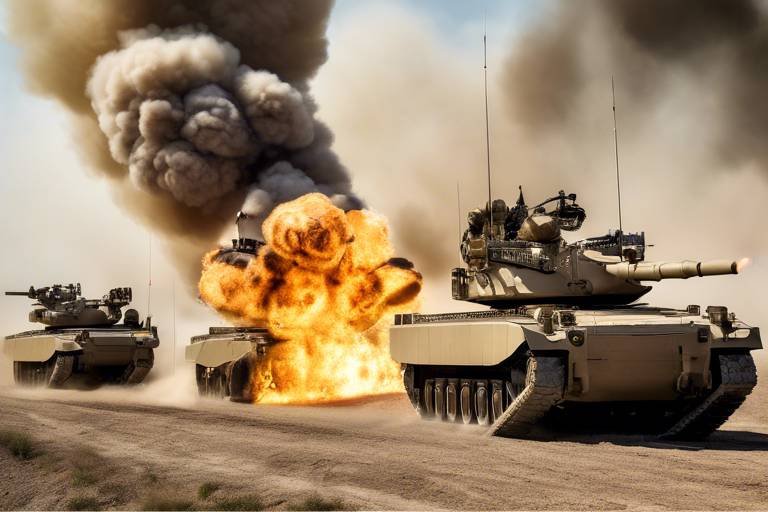Understanding the Development of New Ammunition Types
The world of ammunition has undergone a remarkable transformation over the years, driven by both the demands of warfare and the relentless march of technology. As we delve into the evolution of ammunition types, it's essential to understand not just the how but also the why behind these innovations. From the first primitive projectiles to today's sophisticated munitions, each advancement has been a response to the changing landscape of combat and the need for greater effectiveness.
Historically, ammunition development has mirrored the advancements in weaponry and military strategy. In ancient times, simple stones and arrows evolved into gunpowder-based projectiles that revolutionized warfare. The introduction of firearms in the 15th century marked a significant turning point, setting the stage for the complex ammunition we see today. As we explore the various types of ammunition, it becomes clear that each category serves a unique purpose, tailored to specific combat situations.
Today, we categorize ammunition into several types, including small arms, artillery, and specialty rounds. Each type is designed with particular applications in mind, whether it's for personal defense, military operations, or specialized tactical scenarios. For instance, small arms ammunition is vital for infantry soldiers, while artillery shells provide the heavy firepower needed for larger scale engagements. Understanding these distinctions is crucial for grasping how modern warfare is conducted.
As we move forward, the role of technology in ammunition development cannot be overstated. Innovations such as computer modeling and smart munitions have revolutionized how ammunition is designed and produced. These advancements not only enhance the performance of ammunition but also improve safety and reliability, making them indispensable in contemporary military strategy. The rise of 3D printing technology is another game-changer, allowing for more efficient production processes and customization of ammunition types.
Looking ahead, the future of ammunition development is poised for exciting changes. With a growing emphasis on sustainability, the industry is exploring eco-friendly ammunition options that minimize environmental impact. Additionally, advancements in lethality and safety are shaping how ammunition is developed, ensuring that it meets the evolving needs of modern warfare. As we continue to innovate, the possibilities for new ammunition types are virtually limitless.
In conclusion, understanding the development of new ammunition types is essential for anyone interested in military technology and strategy. The interplay between historical context, technological advancements, and future trends paints a comprehensive picture of an industry that is constantly evolving. As we continue to explore these developments, one thing remains clear: ammunition will always adapt to meet the demands of the battlefield.
- What are the main types of ammunition? The main types include small arms, artillery, and specialty rounds, each designed for specific uses.
- How has technology impacted ammunition development? Technology has led to innovations such as smart munitions and 3D printing, enhancing performance and production efficiency.
- What are specialty rounds? Specialty rounds include tracer, armor-piercing, and hollow-point ammunition, each serving unique tactical purposes.
- What is the future of ammunition development? The future includes eco-friendly options and advancements in lethality and safety to meet modern military needs.
The Historical Context of Ammunition Development
Ammunition has a rich and complex history that mirrors the evolution of warfare itself. From the earliest days of gunpowder to today's high-tech munitions, the journey of ammunition development is a fascinating tale of innovation, necessity, and sometimes, desperation. In the beginning, ammunition was simple—think stones and arrows. However, as societies advanced, so did their weaponry. The introduction of gunpowder in the 9th century revolutionized combat, leading to the creation of early firearms and cannonballs that changed the dynamics of warfare.
Fast forward to the 19th century, and we see significant milestones in ammunition technology. The invention of the Minié ball in the 1850s, for instance, allowed for greater accuracy and range, making rifles far more effective than their predecessors. This period also saw the rise of metallic cartridges, which simplified loading and firing, and paved the way for the modern firearm as we know it today. The transition from muzzle-loading to breech-loading weapons marked a pivotal point in military history, enabling soldiers to fire more rapidly and efficiently.
As we moved into the 20th century, two World Wars spurred unprecedented advancements in ammunition technology. The demands of modern warfare led to innovations such as armor-piercing rounds and explosive shells. These developments were not just about increasing lethality; they also focused on improving safety and usability for soldiers in the field. The Cold War era brought about further innovations, including the introduction of guided munitions, which combined traditional ammunition with cutting-edge technology to enhance precision and reduce collateral damage.
In examining the historical context of ammunition development, it's important to consider the following factors that have shaped its evolution:
- Technological Advancements: Innovations in materials and manufacturing processes have continuously improved ammunition performance.
- Military Needs: The changing nature of warfare has driven the demand for more effective and versatile ammunition types.
- Political and Economic Factors: Wars and conflicts often lead to increased funding for research and development in military technologies.
Today, we stand on the brink of another revolution in ammunition technology, driven by advancements in smart munitions and 3D printing. As we look back at the historical context of ammunition development, we can see a clear trajectory of progress that reflects the ever-evolving needs of military and civilian applications alike. Each era has contributed to the complex tapestry of ammunition technology, setting the stage for future innovations that promise to redefine how we think about and utilize ammunition in the years to come.
Q1: What was the first type of ammunition used in warfare?
A: The first types of ammunition were simple projectiles like stones and arrows used by early civilizations in hunting and combat.
Q2: How did the invention of gunpowder change ammunition?
A: The invention of gunpowder allowed for the development of firearms and explosive projectiles, significantly increasing the range and lethality of weapons.
Q3: What are some modern advancements in ammunition technology?
A: Modern advancements include smart munitions with guidance systems, eco-friendly ammunition, and the use of 3D printing in production.
Types of Modern Ammunition
The world of modern ammunition is as diverse as it is fascinating. With advancements in technology and changes in warfare tactics, the types of ammunition have evolved significantly. Today, we can categorize modern ammunition into several key types, each designed for specific roles and applications. Understanding these categories not only enhances our knowledge of military operations but also sheds light on civilian uses, such as hunting and sport shooting.
One of the primary categories is small arms ammunition, which includes cartridges used in handguns and rifles. These rounds are essential for personal defense, law enforcement, and military operations. The characteristics of small arms ammunition, such as caliber, bullet weight, and design, dictate their effectiveness in various scenarios. For instance, a 9mm round might be favored for its balance of stopping power and recoil, making it ideal for self-defense, while a .223 Remington is commonly used in military rifles for its accuracy and range.
Next, we have artillery shells and munitions. These larger projectiles are designed for use in cannons and howitzers, delivering devastating firepower over long distances. Artillery shells can vary widely in type, including high-explosive, incendiary, and smoke rounds, each serving distinct purposes on the battlefield. The design of these shells has seen significant improvements, with modern artillery often equipped with advanced guidance systems that enhance their accuracy and effectiveness.
Another fascinating category is specialty rounds. These are designed for specific tactical situations, and they include:
- Tracer Rounds: These rounds leave a visible trace of light, allowing shooters to see the trajectory and adjust their aim accordingly.
- Armor-Piercing Rounds: Engineered to penetrate hard targets, these rounds are often used in military applications against armored vehicles.
- Hollow-Point Rounds: Designed to expand upon impact, these rounds are favored for self-defense as they cause more damage to the target while reducing the risk of over-penetration.
In addition to these categories, advancements in materials and technology have also led to the development of non-lethal ammunition. This type is particularly important in law enforcement and crowd control situations, where the goal is to incapacitate rather than kill. Examples include rubber bullets and bean bag rounds, which can effectively subdue individuals while minimizing the risk of fatal injuries.
As we look to the future, the types of modern ammunition will continue to evolve. Innovations in design, materials, and manufacturing processes promise to enhance performance, safety, and environmental sustainability. The ongoing research into biodegradable materials, for instance, aims to reduce the ecological impact of ammunition, reflecting a growing concern for environmental stewardship in both military and civilian contexts.
In summary, the landscape of modern ammunition is rich and varied, encompassing small arms, artillery, specialty rounds, and non-lethal options. Each type serves a unique purpose, shaped by the demands of warfare and civilian needs. As technology advances, we can expect to see even more exciting developments in this critical field.
Small Arms Ammunition
Small arms ammunition is the backbone of both personal defense and military operations, playing a crucial role in various combat scenarios. When we talk about small arms, we’re generally referring to firearms that can be carried and operated by a single person, which includes everything from handguns to rifles. The importance of small arms ammunition cannot be overstated; it is designed to be reliable, effective, and versatile, catering to different needs and environments.
One of the most fascinating aspects of small arms ammunition is the variety of calibers available, each with its own unique characteristics. Common calibers like .22 LR, 9mm, and .45 ACP are widely used due to their specific advantages. For instance, the .22 LR is favored for training and small game hunting because of its low recoil and cost-effectiveness, while the 9mm is a popular choice among law enforcement and military personnel for its balance of size, recoil, and stopping power. Each caliber serves its purpose, and advancements in technology have only enhanced their performance and reliability.
In recent years, innovations in small arms ammunition have led to improvements in materials and manufacturing processes. For example, the introduction of polymer-cased ammunition has reduced weight and improved corrosion resistance, making it ideal for various conditions. Moreover, advancements in bullet design, such as the development of hollow-point and frangible rounds, have increased lethality while minimizing the risk of over-penetration, which is particularly important in urban environments.
Understanding the distinctions between different types of small arms ammunition can also shed light on why certain types are preferred in various shooting disciplines. For example, competitive shooters may opt for match-grade ammunition, which is manufactured to tighter tolerances for improved accuracy. On the other hand, self-defense scenarios often call for ammunition that expands upon impact, ensuring maximum stopping power without excessive penetration.
To illustrate the differences in common small arms ammunition, consider the following table:
| Caliber | Typical Use | Advantages |
|---|---|---|
| .22 LR | Training, small game | Low recoil, inexpensive |
| 9mm | Self-defense, law enforcement | Good balance of size and power |
| .45 ACP | Self-defense | High stopping power |
| 5.56 NATO | Military, tactical | High velocity, low recoil |
In conclusion, small arms ammunition is a dynamic field that continuously evolves with technological advancements and shifting needs. Whether for personal defense or military applications, understanding the various types of small arms ammunition is essential for making informed choices. As we look to the future, innovations in design and materials will undoubtedly further enhance the effectiveness and reliability of small arms ammunition.
- What is the most popular caliber for self-defense? The 9mm is widely regarded as the most popular choice for self-defense due to its balance of stopping power and manageable recoil.
- What are the benefits of hollow-point ammunition? Hollow-point ammunition expands upon impact, creating a larger wound channel while reducing the risk of over-penetration, making it ideal for self-defense scenarios.
- How does ammunition affect firearm performance? The type of ammunition used can significantly affect accuracy, recoil, and overall performance of the firearm, making it crucial to select the right ammunition for specific purposes.
Rimfire vs. Centerfire
When it comes to ammunition, the debate between rimfire and centerfire is one that often sparks interest among enthusiasts and professionals alike. Each type has its own unique characteristics, advantages, and applications, making them suitable for different scenarios. But what exactly sets them apart? Let’s break it down.
At its core, the distinction between rimfire and centerfire ammunition lies in the location of the primer. Rimfire cartridges have the primer located in the rim of the cartridge case, while centerfire cartridges have it located in the center of the base. This fundamental difference influences not only the manufacturing process but also the performance and reliability of each type.
Rimfire ammunition is typically associated with smaller calibers, such as the famous .22 Long Rifle. This type of cartridge is generally cheaper to produce, which makes it a favorite for recreational shooting, training, and small game hunting. The simplicity of rimfire design means that they are often lighter and easier to handle, making them ideal for beginners. However, this design also means that rimfire cartridges tend to be less powerful and have a shorter effective range.
On the other hand, centerfire ammunition is the powerhouse of the two. It is available in a wide variety of calibers, from the common 9mm used in handguns to the .50 BMG used in heavy machine guns. Centerfire cartridges are known for their reliability and performance, especially in high-pressure situations. The design allows for the use of larger primers, which can ignite more propellant, resulting in higher velocities and greater stopping power. This makes centerfire ammunition the preferred choice for military applications and larger game hunting.
Here’s a quick comparison to help illustrate the differences:
| Feature | Rimfire | Centerfire |
|---|---|---|
| Primer Location | Rim of the cartridge | Center of the cartridge base |
| Caliber Range | Typically smaller (e.g., .22 LR) | Wide range (e.g., 9mm, .308, .50 BMG) |
| Cost | Generally cheaper | More expensive |
| Applications | Recreational shooting, small game hunting | Military, law enforcement, large game hunting |
| Reliability | Less reliable under extreme conditions | More reliable, especially in adverse conditions |
In conclusion, the choice between rimfire and centerfire ammunition ultimately depends on the intended use. If you're looking for an affordable option for plinking or small game hunting, rimfire might be your best bet. However, for serious applications where performance and reliability are paramount, centerfire ammunition is the way to go. Understanding these differences can help you make more informed decisions about your ammunition needs.
- What is the main difference between rimfire and centerfire ammunition? The main difference lies in the location of the primer; rimfire has it in the rim, while centerfire has it in the center of the cartridge base.
- Which type of ammunition is more powerful? Centerfire ammunition is generally more powerful and is used for larger calibers and more serious applications.
- Is rimfire ammunition cheaper? Yes, rimfire ammunition is usually cheaper to produce and purchase, making it popular for recreational shooting.
- Can I use rimfire ammunition in a centerfire firearm? No, they are not interchangeable due to their different designs and specifications.
Specialty Rounds
When it comes to ammunition, not all rounds are created equal. are designed with specific purposes in mind, catering to various tactical needs in both military and civilian contexts. These rounds are like the Swiss Army knife of ammunition—each type serves a unique function, whether it's enhancing precision, increasing lethality, or minimizing collateral damage.
One of the most well-known types of specialty rounds is the tracer round. These rounds are equipped with a small pyrotechnic charge that ignites upon firing, leaving a visible trail of light. This feature allows shooters to track their shots in real-time, making it easier to adjust aim and improve accuracy during rapid fire situations. Imagine trying to hit a moving target in low light; tracers illuminate the path, providing instant feedback and enhancing the shooter’s ability to make necessary corrections.
Another type is the armor-piercing round. These rounds are designed to penetrate hard targets, such as body armor and fortified structures. They typically feature a hardened steel or tungsten core, allowing them to breach protective barriers that standard ammunition cannot. In combat scenarios, the ability to defeat armor can be the difference between success and failure, making these rounds invaluable for military personnel.
Hollow-point rounds are also a significant category of specialty ammunition. Designed to expand upon impact, they create a larger wound channel, which can lead to more effective stopping power. This type of round is often favored for personal defense situations, where the goal is to incapacitate a threat quickly while minimizing the risk of over-penetration, which could harm bystanders. Think of it as a flower blooming upon impact—spreading out to maximize its effect while keeping collateral damage at bay.
In addition to these well-known types, there are also less common specialty rounds, such as frangible ammunition. These rounds are designed to disintegrate upon impact with hard surfaces, reducing the risk of ricochet and making them ideal for training environments or situations where safety is paramount. They’re like the soft landing of a parachute, ensuring that even in a high-stakes scenario, the risk to others is minimized.
As we delve deeper into the world of specialty rounds, it’s essential to understand their design features and the roles they play in tactical situations. Each type of specialty round is engineered with specific materials and characteristics that optimize performance for its intended use. For example, the materials used in armor-piercing rounds are selected for their density and hardness, while hollow-point rounds are crafted to ensure reliable expansion upon impact.
In summary, specialty rounds are a testament to the ingenuity of ammunition development. They are not just tools of war; they are carefully designed instruments that enhance the effectiveness of shooters in various scenarios. As technology continues to advance, we can expect even more innovations in specialty ammunition, further expanding the capabilities of military and civilian users alike.
- What are specialty rounds? Specialty rounds are ammunition designed for specific purposes, such as increasing accuracy, penetrating armor, or minimizing collateral damage.
- How do tracer rounds work? Tracer rounds contain a pyrotechnic charge that ignites upon firing, leaving a visible trail to help shooters track their shots.
- What is the purpose of hollow-point ammunition? Hollow-point rounds expand upon impact, creating a larger wound channel and providing effective stopping power while reducing the risk of over-penetration.
- Are frangible rounds safe to use? Yes, frangible rounds are designed to disintegrate upon impact with hard surfaces, minimizing the risk of ricochet and making them ideal for training.
Artillery Shells and Munitions
Artillery shells are the backbone of military firepower, designed to deliver explosive payloads over long distances with remarkable accuracy. These munitions have evolved significantly over the years, driven by the relentless pursuit of greater range, precision, and lethality. At their core, artillery shells are categorized based on their intended use, which can range from high-explosive rounds that devastate enemy positions to specialized munitions designed for specific tactical scenarios.
Modern artillery shells typically fall into several categories, including:
- High-Explosive (HE) Shells: These shells are designed to explode on impact, creating a shockwave that can cause extensive damage to personnel and structures.
- Smoke Shells: Used primarily for screening and obscuring vision, these shells release a cloud of smoke upon detonation, providing tactical advantages on the battlefield.
- Illumination Shells: These are designed to light up the battlefield at night, ensuring visibility for troops and targeting systems.
- Guided Munitions: Equipped with advanced guidance systems, these shells can adjust their trajectory mid-flight, dramatically increasing accuracy.
The design of artillery shells has seen revolutionary changes, especially with the advent of technology. For instance, the integration of computer modeling in the design process allows engineers to simulate various conditions and optimize shell performance before production. This not only enhances the effectiveness of the munitions but also significantly reduces costs and production times.
Another remarkable advancement is the development of smart munitions. These shells are equipped with guidance systems that allow them to hit moving targets with pinpoint accuracy. The implications of this technology for military strategy are profound, as it enables forces to engage targets with minimal collateral damage, a crucial consideration in modern warfare.
Moreover, the materials used in artillery shell construction have also evolved. Modern shells are often made from lightweight yet durable materials, which improve their range and maneuverability. For example, the use of composite materials can reduce the overall weight of the shell while maintaining structural integrity, allowing for longer firing distances.
In summary, artillery shells and munitions are a vital component of military operations, evolving continuously to meet the demands of modern warfare. As technology progresses, we can expect further innovations that will enhance the effectiveness and safety of these essential tools. The future of artillery is not just about bigger and more powerful shells, but also about smarter, more precise munitions that can adapt to the complexities of the battlefield.
- What are the main types of artillery shells? The main types include high-explosive shells, smoke shells, illumination shells, and guided munitions.
- How has technology impacted artillery shell design? Technology has enabled more precise targeting, optimized designs through computer modeling, and the use of advanced materials for better performance.
- What are smart munitions? Smart munitions are artillery shells equipped with guidance systems that allow for increased accuracy and reduced collateral damage.
The Role of Technology in Ammunition Development
The evolution of ammunition technology has been nothing short of revolutionary, reshaping the landscape of warfare and personal defense. As we dive into this fascinating subject, it's essential to recognize how technology plays a pivotal role in enhancing the performance, safety, and effectiveness of ammunition. From the early days of simple gunpowder to today's sophisticated munitions, each advancement has brought us closer to precision and reliability on the battlefield.
One of the most significant advancements in ammunition technology is the incorporation of computer modeling and simulations. These tools allow engineers to design and test ammunition virtually, predicting how it will perform under various conditions without the need for costly and time-consuming physical prototypes. Imagine being able to tweak a design and instantly see the results—this capability has drastically shortened development cycles and improved the quality of the final product.
Moreover, the rise of smart munitions has transformed traditional concepts of warfare. These advanced rounds are equipped with guidance systems that enable them to hit targets with pinpoint accuracy. For instance, a smart bomb can adjust its trajectory mid-flight, ensuring it reaches its intended target while minimizing collateral damage. This level of precision not only enhances military effectiveness but also raises ethical considerations about warfare, as it allows for more strategic engagement with reduced risks to civilians.
In addition to smart munitions, materials science has played a crucial role in the development of modern ammunition. The use of advanced materials, such as lightweight composites and improved propellants, has led to ammunition that is not only more potent but also lighter and easier to carry. This change is particularly beneficial for soldiers who need to carry their gear over long distances. With lighter ammunition, troops can conserve energy and enhance their mobility on the battlefield.
Another exciting innovation is the use of 3D printing technology in ammunition production. This method allows for rapid prototyping and the ability to create complex designs that would be impossible with traditional manufacturing techniques. The benefits of 3D printing in ammunition include:
- Reduced production costs
- Lower material waste
- Customization for specific needs
However, while the advantages are clear, there are challenges as well, such as ensuring the reliability and safety of 3D-printed ammunition in high-stress environments.
As we look to the future, the role of technology in ammunition development will only continue to expand. Innovations like artificial intelligence are expected to play a role in analyzing battlefield data to optimize ammunition selection and deployment. This synergy between technology and ammunition design is paving the way for a new era of military engagement, where decisions can be made in real-time based on comprehensive data analysis.
In conclusion, technology is the driving force behind the evolution of ammunition. As we witness these advancements, it’s crucial to consider not just the implications for military strategy but also the broader societal impacts. How will these technologies change the nature of conflict? What ethical considerations arise as we develop more precise and powerful munitions? These are questions that will shape the future of ammunition development and its role in our world.
Smart Munitions
In the ever-evolving landscape of military technology, have emerged as a game-changer, revolutionizing the way armed forces engage in combat. These advanced weapons are not just about firepower; they incorporate sophisticated guidance systems that enhance their accuracy and effectiveness. Imagine a missile that can adjust its trajectory mid-flight based on real-time data—this is the essence of smart munitions. They are designed to hit their targets with pinpoint precision, reducing collateral damage and increasing mission success rates.
The development of smart munitions is a response to the complex nature of modern warfare, where the battlefield is often crowded with civilians and non-combatants. Traditional munitions, while effective, lack the adaptability that smart munitions offer. By utilizing technologies such as GPS, laser guidance, and even artificial intelligence, these munitions can navigate through challenging environments and strike with remarkable accuracy. For instance, a typical smart bomb can be programmed to follow a specific flight path, adjusting its course based on obstacles or changes in the target's location.
One of the most significant advantages of smart munitions is their ability to reduce unintended casualties. In a world where military operations are scrutinized more than ever, the need for precision is paramount. By limiting the blast radius and focusing on specific targets, smart munitions help military forces achieve their objectives while adhering to ethical standards. This not only enhances the reputation of the military but also fosters trust among the local populations in conflict zones.
However, the integration of smart munitions into military operations is not without its challenges. The technology required for these advanced weapons is expensive, and there are concerns about the potential for cyberattacks that could compromise their effectiveness. Moreover, as these weapons become more prevalent, adversaries are likely to develop countermeasures, which could negate some of the advantages they provide. It's a constant arms race, with each side striving to outsmart the other.
To illustrate the capabilities of smart munitions, consider the following table that compares traditional munitions with smart munitions:
| Feature | Traditional Munitions | Smart Munitions |
|---|---|---|
| Accuracy | Limited | High |
| Collateral Damage | Higher | Lower |
| Cost | Lower | Higher |
| Guidance System | None | GPS, Laser, AI |
As we look to the future, the role of smart munitions is expected to expand even further. With ongoing advancements in technology, we may see the emergence of even more sophisticated systems that can autonomously identify and engage targets. This raises important questions about the ethics of warfare and the role of human decision-making in military operations. As we embrace these innovations, it's crucial to balance technological capabilities with moral responsibilities.
- What are smart munitions? Smart munitions are advanced weapons equipped with guidance systems that enhance their accuracy and effectiveness in targeting.
- How do smart munitions reduce collateral damage? They are designed to hit specific targets with precision, minimizing the risk of harming civilians and non-combatants.
- What technologies are used in smart munitions? Smart munitions utilize GPS, laser guidance, and artificial intelligence to navigate and adjust their flight paths.
- Are smart munitions more expensive than traditional munitions? Yes, the advanced technology involved in smart munitions typically makes them more costly than traditional munitions.
- What are the ethical concerns surrounding smart munitions? There are concerns about the potential for autonomous decision-making in warfare and the implications for human oversight and accountability.
3D Printing in Ammunition Production
The advent of 3D printing technology has been nothing short of revolutionary in various industries, and ammunition production is no exception. Imagine being able to manufacture complex shapes and designs with precision, all from the comfort of a digital blueprint. This innovation not only streamlines the production process but also opens up new avenues for customization and efficiency. Unlike traditional manufacturing methods, which can be time-consuming and labor-intensive, 3D printing allows for rapid prototyping and production, drastically reducing the time from concept to completion.
One of the most significant advantages of 3D printing in ammunition production is the ability to create lightweight and durable materials. Traditional ammunition components often rely on heavy metals, but with advanced materials science, 3D printing can utilize polymers and composite materials that maintain structural integrity while reducing weight. This is particularly beneficial for military applications where every ounce counts, and soldiers need to carry as much ammunition as possible without being weighed down.
Moreover, 3D printing enables manufacturers to produce specialized ammunition types that might not be economically viable through conventional methods. For instance, the ability to create custom rounds tailored for specific firearms or tactical situations means that soldiers can have the right tool for the job, enhancing their effectiveness on the battlefield. The flexibility of design also allows for rapid adjustments based on feedback from the field, ensuring that the ammunition produced meets the evolving needs of modern warfare.
However, the integration of 3D printing in ammunition production does come with its challenges. One major concern is the regulation and safety of 3D-printed ammunition. As with any new technology, there are uncertainties regarding the reliability and performance of printed materials under high-stress conditions. Manufacturers must ensure that their 3D-printed products meet stringent safety standards to prevent failures that could have catastrophic consequences in the field.
In addition, there is the issue of intellectual property. As designs become digital assets, the potential for unauthorized replication or modification increases. This raises questions about how to protect proprietary designs and maintain quality control in an era where information can be easily shared and reproduced.
Despite these challenges, the future of 3D printing in ammunition production looks promising. As technology continues to advance, we can expect to see more efficient production processes, enhanced material properties, and greater customization options. The combination of speed and flexibility offered by 3D printing could very well redefine the landscape of ammunition manufacturing, making it more responsive to the needs of military and civilian users alike.
- What is 3D printing in ammunition production?
3D printing in ammunition production refers to the use of additive manufacturing technology to create ammunition components and rounds from digital designs, allowing for customization and rapid production. - What are the benefits of using 3D printing for ammunition?
Benefits include reduced production time, the ability to create lightweight and durable materials, and the potential for specialized ammunition tailored to specific needs. - Are there safety concerns with 3D-printed ammunition?
Yes, there are concerns regarding the reliability and performance of 3D-printed materials, as well as issues related to regulation and intellectual property protection. - How does 3D printing affect the future of ammunition production?
3D printing is expected to make ammunition production more efficient, flexible, and responsive to the evolving needs of users, potentially transforming the industry.
Future Trends in Ammunition Development
The landscape of ammunition development is continuously evolving, driven by the need for enhanced performance, safety, and environmental considerations. As we look towards the future, several key trends are emerging that are set to redefine how ammunition is designed, manufactured, and utilized. One of the most significant trends is the shift towards eco-friendly ammunition. With increasing awareness of environmental sustainability, manufacturers are exploring biodegradable materials and lead-free alternatives that not only reduce ecological impact but also comply with stricter regulations in various regions.
Moreover, advancements in technology are leading to innovations that enhance both lethality and safety. The integration of smart technologies into ammunition is gaining traction, allowing for precision targeting and minimizing collateral damage. These smart munitions utilize sophisticated guidance systems that can adjust their trajectory mid-flight, ensuring they hit their intended targets with pinpoint accuracy. This not only increases the effectiveness of military operations but also raises ethical considerations regarding the use of such technology in combat scenarios.
Another exciting development is the role of 3D printing in ammunition production. This cutting-edge technology allows for rapid prototyping and customization of ammunition types, enabling manufacturers to respond swiftly to changing military needs. With 3D printing, the production process becomes more efficient, reducing waste and costs associated with traditional manufacturing methods. However, the challenges of ensuring quality and reliability in 3D-printed ammunition remain a topic of ongoing research and development.
In addition to these technological advancements, there is a growing emphasis on modular ammunition systems. These systems allow for interchangeable components that can be tailored to specific missions or requirements. For example, a single cartridge case can be adapted to fire different types of projectiles, providing versatility and logistical advantages in the field. This modular approach not only simplifies supply chains but also enhances the adaptability of military forces in dynamic combat environments.
As we embrace these trends, it's essential to consider the implications for both military and civilian applications. The future of ammunition development is not just about improving performance; it also involves addressing the ethical and environmental challenges that accompany these innovations. Striking a balance between effectiveness and responsibility will be crucial as we move forward in this rapidly changing landscape.
- What are eco-friendly ammunition options? Eco-friendly ammunition typically includes lead-free projectiles and biodegradable materials designed to minimize environmental impact.
- How does 3D printing affect ammunition production? 3D printing allows for faster production, customization, and reduced waste, although quality assurance remains a challenge.
- What are smart munitions? Smart munitions are advanced projectiles equipped with guidance systems that improve targeting accuracy and reduce collateral damage.
- What is modular ammunition? Modular ammunition systems consist of interchangeable components that can be adapted for various missions, enhancing flexibility and logistics.
Frequently Asked Questions
-
What are the main types of modern ammunition?
Modern ammunition can be categorized into several types, primarily including small arms ammunition, artillery shells, and specialty rounds. Each type serves different purposes in military and civilian applications, with small arms being crucial for personal defense and military operations, while artillery shells provide significant firepower on the battlefield.
-
What is the difference between rimfire and centerfire ammunition?
Rimfire ammunition has the primer located in the rim of the cartridge, making it simpler and cheaper to produce, but less powerful. Centerfire ammunition, on the other hand, has the primer located in the center of the cartridge base, allowing for higher pressures and more powerful rounds. This makes centerfire ammunition generally preferred for military and tactical use.
-
What are specialty rounds and their purposes?
Specialty rounds include designs such as tracer, armor-piercing, and hollow-point ammunition. Each type serves unique tactical roles; for instance, tracer rounds allow shooters to see the trajectory of their shots, while armor-piercing rounds are designed to penetrate tough materials, making them effective against armored targets.
-
How has technology influenced ammunition development?
Technology has revolutionized ammunition design through innovations like computer modeling, smart munitions, and advancements in materials science. These technologies contribute to improved accuracy, reliability, and overall performance, making modern ammunition more effective in various combat scenarios.
-
What are smart munitions?
Smart munitions are advanced types of ammunition that incorporate guidance systems for precision targeting. This technology enhances their effectiveness on the battlefield, allowing for more strategic military operations and reducing collateral damage.
-
How is 3D printing changing ammunition production?
3D printing is transforming ammunition manufacturing by allowing for rapid prototyping and production of complex designs. This technology can potentially reduce costs and lead times, but it also presents challenges in terms of quality control and material limitations.
-
What future trends are emerging in ammunition development?
Future trends in ammunition development include a focus on eco-friendly ammunition and advancements aimed at improving both lethality and safety. As military needs evolve, these trends will shape the direction of the industry and influence the design and production of new ammunition types.

